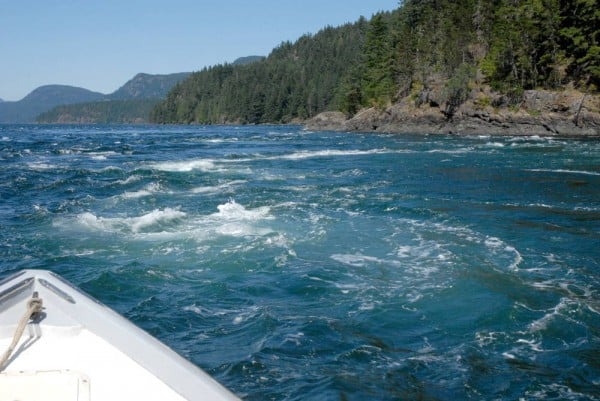Here are some hard-won tips that may come in handy:
Linseed Oil. When I acquired my first sailboat half a century ago, I made a grating to fit the cockpit. My retired houseboat neighbors, who all were involved with boats, saw the grating and asked what wood I had used. I proudly told them I chose hemlock because it was easy to work and cheap. The neighbors withdrew a few steps and conferred. They returned and told me hemlock was a terrible choice for anything exposed to weather. It would twist, turn and rot. But they didn’t leave. They gave me instructions on keeping the grate in good condition: saturate the hemlock in hot linseed oil both to provide the oil Mother Nature forgot and to stabilize the grate.
I followed their advice and sloshed hot linseed oil on the grate twice a year for five years. By then the grating was like a rock. Twenty years later, I sold the boat, which still included the hardest grate in town.
Reverse Currents.

Seymour Narrows, north of the town of Campbell River, British Columbia, and The Narrows, south of Tacoma, Washington, both are very narrow and long. When the tide turns, water in both arrows flows like a fire hose. If you want to go against the flow, it may seem you should forget it and hang out until the tide has turned. But there is another option: the counter flow. There is a very narrow stretch of counter-current about the width of a sidewalk that can carry you along while the rest of the Narrows is galloping the other way.
. . . sign up to the right to get immediate access to this full post,
plus you'll get 10 of our best videos for free.
Get Free Videos& Learn More Join Now!!for Full Access Members Sign In


Peter Heiberg says:
I don’t know who has done more for developing interest in small wooden boats in the Pacific Northwest than Dick. Like most sailors, there were occasions when he was “drawing too much water” but what the hell, look at what he accomplished.
John Carlson says:
Thanks Dick, good information and a pleasure to see you posting here. You are right about the oil. Make it hot and make it a lot as we say in the firehouse. No such thing as too much of a good thing. We are loving our North Shore Dinghy we bought at CWB in 2006. She is a member of the family as any good boat becomes.
Dick Wagner says:
John,
I learned a lot from my houseboat neighbor characters. They used to pass on things that never were in Chapman.
All is better than ever at The Center for Wooden Boats. Come on by and see what we’re up to. And thanks for the good words about the North Shore Dinghy. It is always nice to hear that a boat that was excess to our needs has found such a good home.
Dick
Thomas Buzzi says:
Thanks Dick, for taking the time to pass along this info. I am attempting to use some yellow pine to make some hatch boards and will keep the hot linseed oil treatment in mind. I used antifreeze on the first set to cut down on the checking and the warping but the linseed oil sounds like more in keeping with a wooden medium.
The oars, too, are a great reminder. My latest project is rehabbing a great old Montgomery 17 and oars will be on my gear list. I do believe skulling is the way to go.
Dick Wagner says:
Tom,
I’ve always been glad I learned sculling from an Alaska fisherman on his dory. Twisting the blade is a great way to understand the physics of water, which doesn’t compress. Good luck on your Montgomery 17.
Dick